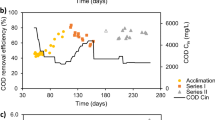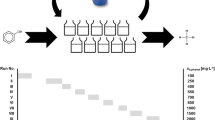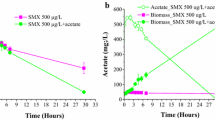Abstract
The complete microbial degradation of thiodiglycol (TDG), the primary hydrolysis product of sulfur mustard, byAlcaligenes xylosoxydans ssp.xylosoxydans (SH91) was accomplished in laboratory-scale stirredtank reactors. An Andrews substrate inhibition model was used to describe the cell growth. The yield factor was not constant, but a relationship with initial substrate concentration has been developed. Using a substrate-inhibition and variable-yield kinetic model, we can describe the cell growth and substrate consumption in batch and repeated batch fermentations. Several reactor-operating modes successfully degrade TDG concentration to below 0.5 g/L. According to the experimental results, the two-stage repeated batch operation has the best degradation efficiency, and it also can degrade 500 mM TDG (≈60 g/L) to 5 mM (≈0.7 g/L) in <5 d. A hypothesis for explaining variable-yield and byproduct formation based on the capacity and utilization of metabolic loads is presented.
Similar content being viewed by others
References
Somani, S. M. (1992),Chemical Warfare Agents, Academic, London.
Yang, Y.-C., Szafraniec, L. L., Beaudry, W. T., and Ward, J. R. (1988),J. Org. Chem. 53(14), 3293–3297.
Sutherland, R. G. (1991), inVerification of Dual-Use Chemicals Under the Chemical Weapons Convention: The Case of Thiodiglycol, Lundin, S. J., ed., Oxford University Press, New York, p. 32.
Bentley, W. R, Bunnett, J. F., DeFrank, J. J., Fahnestock, M. V., Haley, M. V., Harvey, S. P., Isaacson, J. J., Kilbane, J. E., Kolakowski, M. P., Labare, J.-L., and Ontiveros, J. R. (1994), in Proceedings of the 1993 Scientific Conference on Chemical Defense Research, Aberdeen Proving Ground, Maryland pp. 1133–1138.
Lee, T.-S., Pham, M. Q., Weigand, W. A., Harvey, S. P., and Bentley, W. E. (1996),Biotechnol. Prog.,12, 533–539.
Pham, M. Q., Weigand, W.A., Harvey, S.P., and Bentley, W.E. (1995),Appl. Biochem. Biotechnol,57/58, 779–789.
Black, R. M., Brewster, K., Clarke, R. J., Hambrook, J. L., Harrison, J. M., and Howells, D. J. (1993),Xenobiotica 23, 473–481.
Zulty, J. J., DeFrank, J. J., and Harvey, S. P. (1994), in Proceedings of the Scientific Conference on Chemical and Biology Defense Research, Edgewood Research Development and Engineering Center, p. 68.
Lee, T.-S. (1994), UsingAlcaligenes xylosoxidans xylosoxidans, (SH91) to degrade thiodiglycol, the product of sulfur mustard hydrolysis, M.S. thesis. University of Maryland, College Park, MD.
Andrews, J. F. (1968),Biotechnol. Bioeng. 10, 707–723.
Author information
Authors and Affiliations
Rights and permissions
About this article
Cite this article
Lee, TS., Weigand, W.A. & Bentley, W.E. Observations of metabolite formation and variable yield in thiodiglycol biodegradation process. Appl Biochem Biotechnol 63, 743–757 (1997). https://doi.org/10.1007/BF02920472
Issue Date:
DOI: https://doi.org/10.1007/BF02920472




